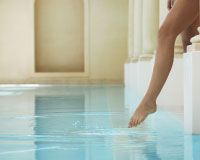Ever heard of salt caves, infrared saunas, hot bamboo massage and ear candling? Or how about Brazilian blowout, Era III medicine, Kelo Saunas, Dry Flotation beds or Rasul Mud Treatments? No, they are not a type of adult entertainment, but popular spa treatments.
Such is the popularity of spas, considered part of what is termed the “wellness market”, that the sector has seen massive growth over the past 10 years in the UK and Europe.
Between 2008 and 2010 no fewer than14.6m people visited a spa in Europe, while according to SpaFinder (www.spafinder.co.uk), one-quarter of all people questioned in the UK visited a spa in 2009 (latest available data).
During that year, the average annual number of visits was three and the average treatment spend was £225.
Globally, the wellness industry was worth around $2 trillion in 2010, according to research by SRI International.
“The spa market is massive on a worldwide basis and is growing significantly,” says David Harper, of Leisure Property Services. “It forms a small part of the overall wellness market (around 3.1%), but has a more significant impact than mere revenues suggest, as the spa forms a platform for many other categories to feature.”
This is all very positive for the sector but, as Hugh Anderson, a partner in the hospitality and leisure team at Edward Symmons, points out, while the health and leisure market continues to develop, “investment in the spa sector is reliant on the ‘feel good factor’ and, with the economic slowdown, discretionary spend remains sensitive”.
High-profile closures
Despite the public’s love of being pampered, spas are suffering, and there have been some high-profile closures (see panel, right).
These businesses are failing because of the on-going credit crunch – lower levels of lending; high loan-to-values hitting owners when loans need refinancing; trading down leading to problems repaying interest on debt; and oversupply in certain areas.
Harper says: “The disappearance of net disposable income has led to a lower volume of business and less”rated” business, meaning that in some cases revenue has fallen by almost 50%.”
He adds that the sector has also been hit by increases in costs, with rises in property taxes (2010 rating revaluation), company taxes (budget), staff costs, VAT on tariffs, food costs and energy prices. “All in all, profit is lower and, as debt is significantly more expensive, this has led to more difficulties with loan repayments.”
Ironically, increased competition, because of the popularity of spas during the boom times, has also affected the sector. Over the past four years, according to SpaFinder, the UK has seen a marked increase in competition for the day spa and residential guest market.
SpaFinder’s research has found that increased development has had the effect of reducing profit, with more established spa clients tempted to go elsewhere. Businesses that relied on their past reputations have had to upgrade their facilities to compete.
But spas are fighting back against the economic problems and winning ground, albeit slowly. “Spas are responding with promotions,” says SpaFinder. “They are offering complimentary services and discounted room and spa rates, as well as exclusive services and all-inclusive spa packages.”
Nine in ten global travel agents report that this year, hotel, resort and destination spas are actually offering more deals, or holding firm on special offers and low pricing, compared with 2010, says SpaFinder.
Spas are also fighting back through better branding, and by focusing on the medical benefits of spa treatment.
Branding, says SpaFinder, “can drive demand as it allows the customers of what is still a relatively new experience to feel secure that they are visiting something with service criteria that will ensure a satisfactory experience.”
More mainstream
Harper adds: “This is likely to change in the future as spa visits become more mainstream, but branded products will probably have an advantage for at least the next five years.”
Meanwhile, “wellness” is seen as the new theme driving spa visitation from a luxury to a requirement. “Concentrating on prevention rather than pampering has been shown to be a successful marketing strategy,” says Harper.
“Even better is preventative pampering”, he adds. “There are certain areas that can be targeted, including medical and wellness tourism, physiotherapy, corrective massage, corrective facials and anti-ageing. Existing customers are prepared to consider exploring all these areas – if they have the option.”
Then there is the illusive male market. In recent years, men have greatly increased their use of spa treatments. According to Harper, UK spa operators estimate that their client base today is 76% female and 24% male. But only as recently as 2004 it was 92% female and 8% male.
“There is an industry-wide recognition that spas need to encourage more male participation, and to change the perception that the sector is a female domain,” says Edward Symmon’s Anderson.
It may take some time before the spa is perceived as a wellness centre for men and women rather than as just a female pampering palace, but by targeting the medical benefits of treatment, the future of the spa could be restored to health.
Spa failures and receiverships
Von Essen (whole portfolio) in April 2011: the following hotels with spas – Cliveden, Berkshire; Royal Crescent, Bath; Hotel Verta, London; Seaham Hall, County Durham; Bishopstrow House and Woolley Grange, Wiltshire; Congham Hall, Norfolk; Dalhousie Castle, Scotland; The Greenway, Gloucestershire; Homewood House and Mount Somerset, Somerset; New Park Manor, Hampshire; Fowey Hall, Cornwall; Moonfleet Manor, Dorset; Ickworth, Suffolk; The Elms, Worcestershire.











